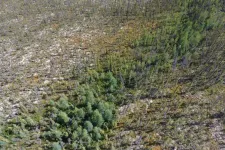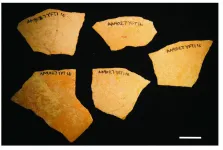(Press-News.org) Tomorrow's cutting-edge technology will need electronics that can tolerate extreme conditions. That's why a group of researchers led by Michigan State University's Jason Nicholas is building stronger circuits today.
Nicholas and his team have developed more heat resilient silver circuitry with an assist from nickel. The team described the work, which was funded by the U.S. Department of Energy Solid Oxide Fuel Cell Program, on April 15 in the journal Scripta Materialia.
The types of devices that the MSU team is working to benefit -- next-generation fuel cells, high-temperature semiconductors and solid oxide electrolysis cells -- could have applications in the auto, energy and aerospace industries.
Although you can't buy these devices off the shelf now, researchers are currently building them in labs to test in the real world, and even on other planets.
For example, NASA developed a solid oxide electrolysis cell that enabled the Mars 2020 Perseverance Rover to make oxygen from gas in the Martian atmosphere on April 22. NASA hopes this prototype will one day lead to equipment that allows astronauts to create rocket fuel and breathable air while on Mars.
To help such prototypes become commercial products, though, they'll need to maintain their performance at high temperatures over long periods of time, said Nicholas, an associate professor in the College of Engineering.
He was drawn to this field after years of using solid oxide fuel cells, which work like solid oxide electrolysis cells in reverse. Rather than using energy to create gases or fuel, they create energy from those chemicals.
"Solid oxide fuel cells work with gases at high temperature. We're able to electrochemically react those gases to get electricity out and that process is a lot more efficient than exploding fuel like an internal combustion engine does," said Nicholas, who leads a lab in the Chemical Engineering and Materials Science Department.
But even without explosions, the fuel cell needs to withstand intense working conditions.
"These devices commonly operate around 700 to 800 degrees Celsius, and they have to do it for a long time -- 40,000 hours over their lifetime," Nicholas said. For comparison, that's approximately 1,300 to 1,400 degrees Fahrenheit, or about double the temperature of a commercial pizza oven.
"And over that lifetime, you're thermally cycling it," Nicholas said. "You're cooling it down and heating it back up. It's a very extreme environment. You can have circuit leads pop off."
Thus, one of the hurdles facing this advanced technology is rather rudimentary: The conductive circuitry, often made from silver, needs to stick better to the underlying ceramic components.
The secret to improving the adhesion, the researchers found, was to add an intermediate layer of porous nickel between the silver and the ceramic.
By performing experiments and computer simulations of how the materials interact, the team optimized how it deposited the nickel on the ceramic. And to create the thin, porous nickel layers on the ceramic in a pattern or design of their choosing, the researchers turned to screen printing.
"It's the same screen printing that's used to make T-shirts," Nicholas said. "We're just screen-printing electronics instead of shirts. It's a very manufacturing-friendly technique."
Once the nickel is in place, the team puts it in contact with silver that's melted at a temperature of about 1,000 degrees Celsius. The nickel not only withstands that heat -- its melting point is 1,455 degrees Celsius -- but it also distributes the liquified silver uniformly over its fine features using what's called capillary action.
"It's almost like a tree," Nicholas said. "A tree gets water up to its branches via capillary action. The nickel is wicking up the molten silver via the same mechanism."
Once the silver cools and solidifies, the nickel keeps it locked onto the ceramic, even in the 700 to 800 degree Celsius heat it would face inside a solid oxide fuel cell or a solid oxide electrolysis cell. And this approach also has the potential to help other technologies, where electronics can run hot.
"There are a wide variety of electronic applications that require circuit boards that can withstand high temperatures or high power," said Jon Debling, a technology manager with MSU Technologies, Michigan State's tech transfer and commercialization office. "These include existing applications in automotive, aerospace, industrial and military markets, but also newer ones such as solar cells and solid oxide fuel cells."
As a technology manager, Debling works to commercialize Spartan innovations and he's working to help patent this process for creating tougher electronics.
"This technology is a significant improvement -- in cost and temperature stability -- over existing paste and vapor deposition technologies," he said.
For his part, Nicholas remains most interested in those cutting-edge applications on the horizon, things like solid oxide fuel cells and solid oxide electrolysis cells.
"We're working to improve their reliability here on Earth -- and on Mars," Nicholas said.
INFORMATION:
Also contributing to the project were Spartan engineering researchers Assistant Professor Hui-Chia Yu, Professor Timothy Hogan and Professor Thomas Bieler. Graduate student researchers on the project included Genzhi Hu, Quan Zhou, Aiswarya Bhatlawande, Jiyun Park, Robert Termuhlen and Yuxi Ma (Zhou, Bhatlawande and Ma have since graduated).
One of the project's coleaders at Brown University, Professor Yue Qi, also has ties to MSU. She served as faculty and the inaugural associate dean of inclusion and diversity in the College of Engineering through 2020.
New research indicates that the computer-based models currently used to simulate how Earth's climate will change in the future underestimate the impact that forest fires and drying climate are having on the world's northernmost forests, which make up the largest forest biome on the planet. It's an important understanding because these northern forests absorb a significant amount of Earth's carbon dioxide.
The finding, reached by studying 30 years of the world's forests using NASA satellite imaging data, suggests that forests won't be able to sequester as much carbon ...
In a novel effort to combat COVID-19 misinformation, a group of women researchers, including nurse scientists from the University of Pennsylvania School of Nursing (Penn Nursing), launched the Dear Pandemic social media campaign in March 2020. It delivers curated, comprehensive, and timely information about the COVID-19 pandemic in a question-and-answer format. Complex topics such as COVID-19 aerosol transmission, risk reduction strategies to avoid infection, and excess mortality are explained in common language and shared widely.
Now with more than 100,000 followers and accounts on Facebook, ...
FINDINGS
A UCLA-led study shows that physicians frequently order preventive medical services for adult Medicare beneficiaries that are considered unnecessary and of "low value" by the U.S. Preventive Services Task Force -- at a cost of $478 million per year.
The researchers analyzed national survey data over a 10-year period, looking specifically at seven preventive services given a "D" rating by the task force, and discovered that these services were ordered more than 31 million times annually.
BACKGROUND
The U.S. Preventive Services Task Force, an independent panel appointed by the Department of Health and Human Services, makes recommendations on the value of clinical preventive ...
The field of soft robotics has exploded in the past decade, as ever more researchers seek to make real the potential of these pliant, flexible automata in a variety of realms, including search and rescue, exploration and medicine.
For all the excitement surrounding these new machines, however, UC Santa Barbara mechanical engineering professor Elliot Hawkes wants to ensure that soft robotics research is more than just a flash in the pan. "Some new, rapidly growing fields never take root, while others become thriving disciplines," Hawkes said.
To help guarantee the longevity of soft robotics ...
New York, NY--Research-practice partnerships (RPPs), long-term collaborations between researchers, policy makers and practitioners, represent an especially promising strategy for making sure that all children benefit from early childhood education, according to END ...
People living with a child who attends school in-person have an increased risk of reporting evidence of COVID-19, but teacher masking, symptom screening, and other mitigation measures in schools may be able to minimize that excess risk, suggests a study led by researchers at the Johns Hopkins Bloomberg School of Public Health.
For their study, the researchers analyzed nearly 600,000 responses from an ongoing Facebook-based COVID-19 symptom survey in the United States over two periods between November 2020 and February 2021 before vaccines were widely available in the U.S. The researchers found that those living with a child engaged in full-time, ...
April 29, 2021 -An increasing number of digital mental health interventions are designed for adolescents and young people with a range of mental health issues, but the evidence on their effectiveness is mixed, according to research by Columbia University Mailman School of Public Health and Spark Street Advisors.
Computerized cognitive behavioral therapy was found effective for anxiety and depression in adolescents and young people holding promise for increasing access to mental health treatment for these conditions. However, the effectiveness of other digital interventions, including therapeutic video games, mobile apps, or social networking sites, and addressing a range of other mental health outcomes remain ...
Archeologists have learned a lot about our ancestors by rummaging through their garbage piles, which contain evidence of their diet and population levels as the local flora and fauna changed over time.
One common kitchen scrap in Africa -- shells of ostrich eggs -- is now helping unscramble the mystery of when these changes took place, providing a timeline for some of the earliest Homo sapiens who settled down to utilize marine food resources along the South African coast more than 100,000 years ago.
Geochronologists at the University of California, Berkeley, and the Berkeley ...
The European house mouse has invaded nearly every corner of the Americas since it was introduced by colonizers a few hundred years ago, and now lives practically everywhere humans store their food.
Yet in that relatively short time span -- 400 to 600 mouse generations -- populations on the East and West Coasts have changed their body size and nest building behavior in nearly identical ways to adapt to similar environmental conditions, according to a new study by biologists at the University of California, Berkeley.
To make these adaptations -- at least in the case of body size -- mice in the Western United States ...
Research has shed new light on the impact of humans on Earth's biodiversity. The findings suggest that the rate of change in an ecosystem's plant-life increases significantly during the years following human settlement, with the most dramatic changes occurring in locations settled in the last 1500 years.
An international research team studied fossilised pollen dating back 5000 years, extracted from sediments on 27 islands. By analysing the fossils they were able to build up an understanding of the composition of each island's vegetation and how it changed from the oldest to the most recent pollen samples.
The study was led by Dr Sandra Nogué, Lecturer in Palaeoenvironmental ...



